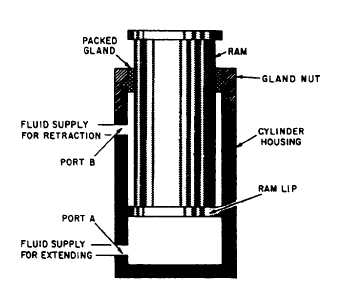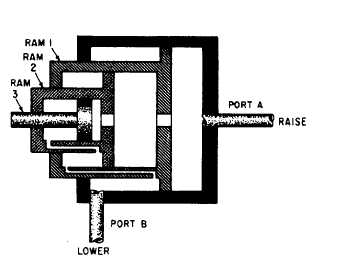is no provision for retracting the ram by fluid
power, when fluid pressure is released, either the
weight of the object or some mechanical means,
such as a spring, forces the ram back into the
cylinder. This forces the fluid back to the
reservoir.
The single-acting ram-type actuating cylinder
is often used in the hydraulic jack. The elevators
used to move aircraft to and from the flight deck
and hangar deck on aircraft carriers also use
cylinders of this type. In these elevators, the
cylinders are installed horizontally and operate the
elevator through a series of cables and sheaves.
Fluid pressure forces the ram outward and lifts
the elevator. When fluid pressure is released from
the ram, the weight of the elevator forces the ram
back into the cylinder. This, in turn, forces the
fluid back into the reservoir.
Double-Acting Ram
A double-acting ram-type cylinder is illustrated
in figure 10-2. In this cylinder, both strokes of
the ram are produced by pressurized fluid. There
are two fluid ports, one at or near each end of
the cylinder. Fluid under pressure is directed to
the closed end of the cylinder to extend the ram
and apply force. To retract the ram and reduce
the force, fluid is directed to the opposite end of
the cylinder.
A four-way directional control valve is
normally used to control the double-acting ram.
When the valve is positioned to extend the ram,
pressurized fluid enters port A (fig. 10-2), acts on
Figure 10-2.—Double-acting ram-type actuating cylinder.
the bottom surface of the ram, and forces the ram
outward. Fluid above the ram lip is free to flow
out of port B, through the control valve, and to
the return line in hydraulic systems or to the
atmosphere in pneumatic systems.
Normally, the pressure of the fluid is the same
for either stroke of the ram. Recall from chapter
2 that force is equal to pressure times area
(F= PA). Notice the difference of the areas upon
which the pressure acts in figure 10-2. The
pressure acts against the large surface area on the
bottom of the ram during the extension stroke,
during which time the ram applies force. Since
the ram does not require a large force during the
retraction stroke, pressure acting on the small area
on the top surface of the ram lip provides the
necessary force to retract the ram.
Telescoping Rams
Figure 10-3 shows a telescoping ram-type
actuating cylinder. A series of rams is nested in
the telescoping assembly. With the exception of
the smallest ram, each ram is hollow and serves
as the cylinder housing for the next smaller ram.
The ram assembly is contained in the main
cylinder assembly, which also provides the fluid
ports. Although the assembly requires a small
space with all the rams retracted, the telescoping
action of the assembly provides a relatively long
stroke when the rams are extended.
An excellent example of the application of this
type of cylinder is in the dump truck. It is used
to lift the forward end of the truck bed and dump
the load. During the lifting operation, the greatest
force is required for the initial lifting of the load.
Figure 10-3.—Telescoping ram-type actuating cylinder.
10-2




